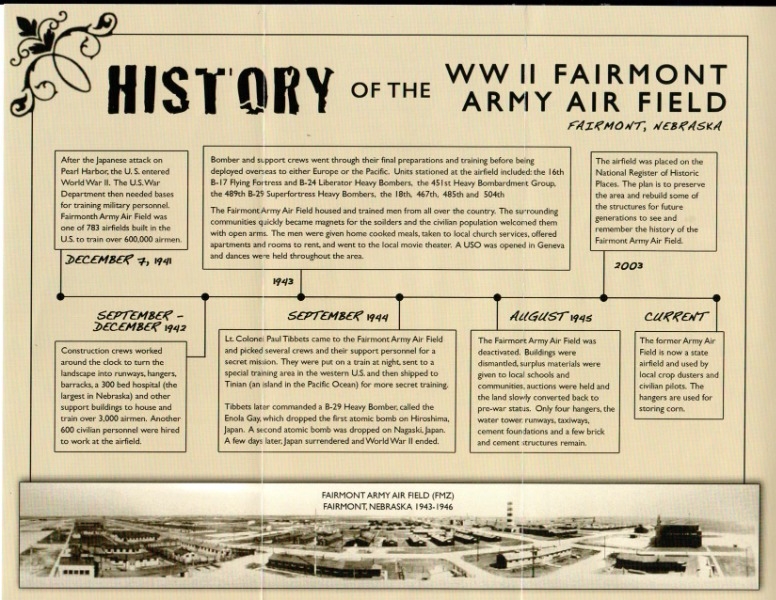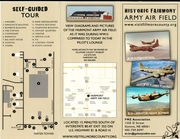Fairmont Army Airfield
Fairmont Army Airfield
After the Japanese attack on U. S. Navel and Air Forces in and around Pearl Harbor, Hawaii, on December 7th, 1941, the U. S. War Department needed bases for training military personnel. A 1,980 acre tract of agricultural land was selected for an Army airfield. It was located between the rural Nebraska towns of Fairmont and Geneva. Two other airfields were also constructed near Bruning and Harvard.
Within ninety days, from September to December, 1942, construction crews, working around the clock, turned the landscape into runways, hangers, barracks, the largest hospital in Nebraska , and other support building to house and train over 3,000 airmen. Another 600 civilian personnel were hired to work at the base. The official name for the base was The Fairmont Army Airfield.
Over the next three years bomber and support crews went through their final preparations and training before being deployed overseas either to Europe or to the Pacific. Units stationed at the air base during those years included: the 451st Heavy Bombardment Group, the 485th, the 504th, the 16th (training in B-17 Flying Fortress and B-24 Superfortess heavy bombers,). Throughout the U. S. there were 345 major airfields and 438 auxiliary airfields built to train over 600,000 airmen. There were 11 major airfields constructed in Nebraska up to 1943.
The Fairmont Army Airfield housed and trained airmen from all over the country and the surrounding towns quickly became magnets for the men and the civilian population welcomed them with open arms. The men were given home cooked meals, taken to local church services, a theater to attend, a USO was opened, apartments were rented, and dances were held. Everyone knew that their stay would be a short one and then they would be gone.
In September, 1944, Lt. Colonel Paul Tibbets came to the Fairmont Army Airfield and picked several crews and their support personnel for a secret mission. They were put on a train at night, sent to a special training area in the western U. S., and then were shipped to an island in the Pacific, called Tinian, for more secret training. Tibbets later commanded a B-29 heavy bomber, called the Enola Gay, which dropped the first atomic bomb on Hiroshima, Japan. A second atomic bomb was dropped on Nagasaki, Japan a few days later. Japan surrendered and World War II was over.
After Japan's surrender in August, 1945, the Fairmont Army Airfield was deactivated. Buildings were dismantled, surplus materials were given to local schools and communities, auctions were held, and the land slowly converted back to pre-war status. Only four hangers, the water tower (recently painted in WWII colors), runways, taxiways, cement foundations, and a few brick and cement structures remain. Now a state airfield, the former base is still used by crop dusters, local \ civilian pilots, and as storage for corn in the hangers.
In 2003, the airfield was chosen as a National Historic Site. It is hoped that the area can be preserved and some of its contents rebuilt for future generations to see and remembered.
Contact Doug Rung for more information. 402-759-0597








